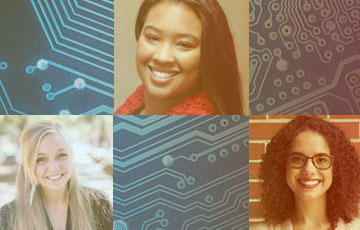This article was originally published as “Women at UF choose life sciences over computer engineering” at Gainesville.com.
Valeria Clark was first exposed to computer engineering when she met friends through online video games who would create different gaming programs.
“I didn’t really know what ‘engineering’ was until I got to college,” the 21-year-old said. “I wasn’t introduced to it at all in school growing up, aside from learning what it was through guy friends who I played video games with.”
Clark, a microbiology senior in the University of Florida’s College of Agricultural and Life Sciences, attributes the initial interest in her career to watching her father be a physician’s assistant.
Enrollment data from fall 2015 shows overwhelming differences between men and women majors in science, technology, engineering and mathematics (STEM) in UF’s Herbert Wertheim College of Engineering, compared with women in STEM majors considered life sciences.
“Unfortunately, I feel like people consider engineering and tech as more masculine; when you think of an engineer, the first gender someone probably thinks of is a male,” Clark said. “I believe many men follow that career path because it’s what they think society expects from them.”
In fall 2015, men accounted for approximately 72 percent of undergraduates studying STEM majors in the College of Engineering, while women accounted for 28 percent. For fall 2015 in the College of Agricultural and Life Sciences, women made up 69 percent of undergraduate STEM majors, while men accounted for 31 percent.
UF computer engineering major Lexie Krehbiel said the difference is something you notice, like how women are easier to spot in these classes.
“My professor will know my name a lot sooner that my male counterparts simply because I am unique in being a female,” the 22-year-old said. “There is less anonymity in being a female.”
Krehbiel said although it’s something to get used to at the beginning, she sees it as an advantage when it comes to getting to know her professors. She says she has had a positive experience despite being in mostly male-dominated classes.
“I haven’t felt that people underestimate me simply for being a female,” she said.
Krehbiel said she thinks the big gap between men and women is tied into the way women are raised in general.
“We are more likely to say to girls, ‘you’re pretty and you’re nice,’ where we are more likely to say to boys, ’you’re athletic and you’re smart,” Krehbiel said. “We’re not really teaching boys to be nice and altruistic in the way we teach girls.”
Krehbiel said she believes most women are taught to be more altruistic than men, which is why she believes a lot more women go into life sciences with the intent to work as medical professionals rather than fields like computer engineering. They don’t see those opportunities available with engineering and technology majors.
Ana Jelacic, a 22-year-old UF computer science senior, is the president of Women in Computer Science. She said the club’s purpose is to promote much-needed diversity in some academic areas.
The club also allows women to connect with other women creating a support system, but the organization also has men as members.
“I wanted to show you can be a guy and work towards diversity,” Jelacic said.
Christina Gardner-McCune, an assistant professor for the Department of Computer and Information Science and Engineering in UF’s College of Engineering, said her interest in science and math from a young age fostered her passion for computer science.
Gardner-McCune said women would likely be more interested in male-dominated STEM fields, such as computer science and technology, if they were given opportunities to study it earlier in their academic careers.
“One of the main factors is that women aren’t exposed to it earlier in their K-12 education, so when they get to undergrad, they feel behind,” Gardner-McCune said. “Right now, computer science is not taught K-12, whereas I took science, math, language arts and history every year from the time I was in first grade, all the way up to the point I was in high school.”
Gardner-McCune said students don’t usually take a computer science course until high school, and agrees that early exposure can make a big difference.
“I think that’s one of the major things, it’s a comfort zone,” Gardner-McCune said. “I was always good at math and science all throughout school, so I think not having that exposure early on makes a big difference; I think it makes a huge difference.”
